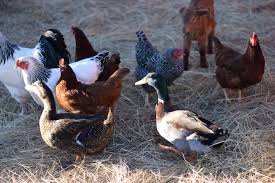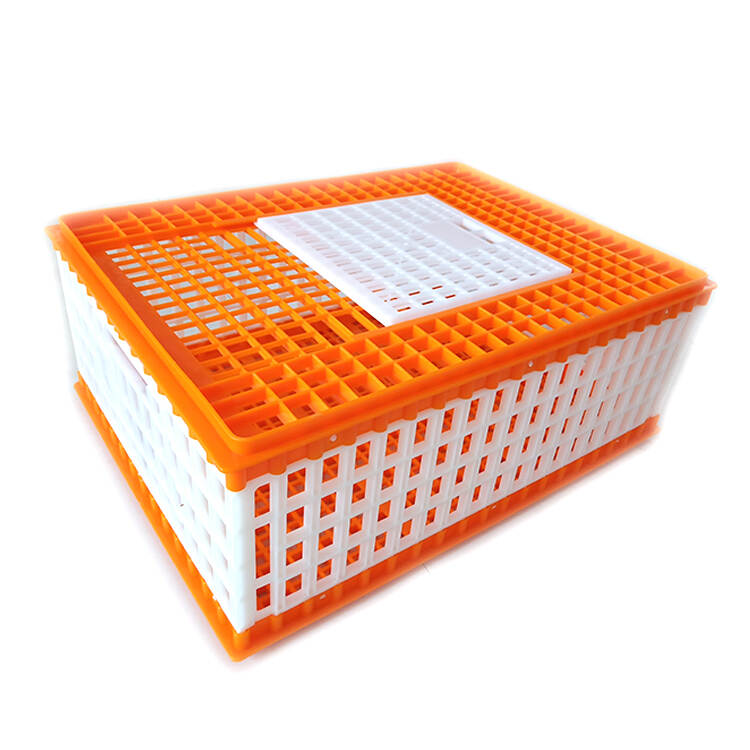Must Know Of Poultry Transportation
February 18,2021
It takes several weeks for chickens to grow, and it takes a lot of time and energy for breeders to keep them healthy until they become food. If there is an error on the last day, it will reduce the quality and value of the meat. So you must take care of the chickens before they get out of your hands. The space where the chickens are located is also very important, including during transportation.

There are something often happened in transportation
If the vehicle is loaded rough, or the chicken is pushed into a box with too small opening, it is crowded so that it is trampled, suffocated or pecked, which may damage the chicken. All these situations can be avoided if the method of transportation is suitable for the size of the bird.
The plastic chicken coop with sliding door near the middle of the top is light in weight, easy to clean and well ventilated. It can be purchased from Qingdao haimu husbandry. They are easy to stack, and if you always pack the same number of chickens into the box, it can help you count the number of chickens. There are also many wooden poultry transport cages with these functions, but these are usually larger and heavier than plastic poultry transport cages, and are prone to mold and difficult to clean.
It is inevitable to encounter wind and rain during the transportation journey, and it looks very confused and muddy when it arrives. Many cages have broken fasteners or openings and cannot be operated by one person. From the amount of manure in the cages, it is clear that some owners forget to remove the feed on the last day. The slaughterhouse has an area where chicken coops can be stored, but there is no area covered by trailers or pickup trucks. Therefore, if you do not use chicken coops, you should provide sufficient road coverage and wait for a short time after arrival.
Choose a suitable poultry transport cage during transportation, and choose a small cage for the corresponding chicks. In addition to the choice of cage, the preparations and precautions before transportation also need to be paid attention to.

Must know in poultry transportation
Do a good job before shipment
Preventing poultry from losing fat during transportation is one of the most concerned issues for all traffickers and transporters. 7-10 days before poultry shipment, the feeding habits should be gradually changed according to the feeding standards and feeding methods during transportation, so as to improve the transportation adaptability of the poultry, reduce the stress response, and reduce the fat loss rate. Poultry generally do not break out of serious diseases such as Newcastle disease and highly pathogenic avian influenza during transportation, but they are prone to outbreaks of avian cholera, which can cause heavy losses. Special attention should be paid.
For poultry that has not been vaccinated with avian cholera disease (bacteria) vaccine, 0.5 to 1 ml of G190E40 or B26-T1200 attenuated vaccine should be injected into each feather 15-20 days before departure, and immunity can be obtained within 3 to 5 days. Mixing 0.01% to 0.05% oxytetracycline powder or 0.06% olaquindox in the feed 10-15 days before the departure will also have a good prevention and control effect on fowl cholera.
All utensils such as trucks, ships, cages and other equipment used for loading poultry must be cleaned and washed beforehand, and exposed to the sun for 2 to 3 days, and then 3% sodium hydroxide solution, 1:300-400 toilet, 1:3000 hundred Any liquid medicine such as poison is sprayed and disinfected. Cars, boats and other confined spaces can be disinfected by formalin fumigation. Use 42ml formalin, 21g potassium permanganate and 21ml water per cubic meter of space for 15-24 hours, and wait for the smell of medicine to dissipate. Poultry can then be shipped.
If the transportation distance is long, feed and feeding troughs, tarpaulins, raincoats, flashlights, buckets, necessary medicines and disinfection utensils should be prepared according to the transportation requirements. Poultry should be fed 80% full, drink enough water before shipment, carefully remove diseases, disability, and weak, and then pack them according to weight, sex and age. Escorts should carry valid documents such as ID cards, driving licenses, quarantine and disinfection certificates of origin, etc., to facilitate smooth transportation to the destination.
Nice conveyance
When the destination is near and the transportation volume is small, bamboo baskets, cartons, etc. can be used for transport. This method is particularly suitable for transporting young birds. When carrying, the bamboo baskets and cartons should be tied up and tied up evenly to avoid the poultry crowding and injury caused by tilting. When the temperature is high, it is better to carry it early and late. During the day, use wide-leaf branches to cover the shade; in cold weather, pad clean straw, cloth or plastic film around the equipment; beware of collision and excessive vibration during transportation.
When the destination is far and the volume is large, it can be transported by car. Choose a cage made of bamboo or iron wire, and be padded with clean straw at the bottom of the cage to reduce the impact of vibration on the poultry; the cage should be tightened and fixed with soft iron wire to prevent the poultry from tipping over on the way. Poultry are caged separately according to weight, sex, age, etc. Leave 1/3 of each cage free to prevent overcrowding. During poultry transportation, windows should be opened for ventilation, and the temperature and humidity changes in the transportation equipment and the health of the poultry should be checked at any time, so as to clean up the feces and add feeding water in time.
Do a good job in transportation quarantine
Before poultry is transported, it is necessary to go to the local animal health administrative department for pre-quarantine, and at the same time do a self-inspection to prevent the occurrence and spread of the epidemic. Poultry is concentrated during transportation, the environment is not good, disease resistance will be reduced, and disease will be more susceptible to infection, and it will soon spread to the whole group, and may also be transmitted to poultry in the transit area. Therefore, transportation quarantine must be well controlled. Timely discover, eliminate and harmlessly treat sick and dead poultry. As long as the transportation and quarantine work is done well, it can prevent the spread of diseases through transportation, control the morbidity and mortality of poultry during transportation, and improve the efficiency of breeding and trafficking.
Pay attention to the stress response of poultry during transportation
During transportation, poultry are mostly in a highly stressed state, with increased energy consumption and increased basal metabolism. 1% to 2% protein should be added to the feed. At the same time, appropriate amounts of lysine and multivitamins should be added according to the instructions for use. Feed some green fodder. When the stress reaction is severe, chlorpromazine hydrochloride can be added to the drinking water in an amount of 1 to 2 ml/kg of body weight, or poultry can drink by themselves 1 to 2 times a day (1 to 2 hours each time) oral rehydration salt, etc. , Both have better results.
Resolutely deal with infectious diseases that occur during transportation
If infectious diseases are found in poultry during transportation, the sick and dead poultry shall be treated as soon as possible; the suspicious poultry shall be isolated to a corner of the transportation vehicle, and then the poultry shall be disinfected and administered for prevention and control. In the event of a type of infectious disease and an infectious disease that has been extinguished or has never been prevalent in the local area, the escorts should immediately report to the nearest livestock and poultry administrative department, and ask them to organize the extinguishment and disposal of poultry carcasses and contaminate tools, utensils, personnel, and sites Such as disinfection to prevent the spread of the epidemic.
